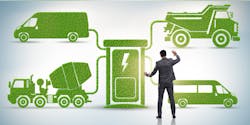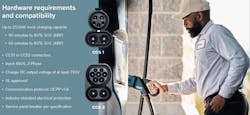Experts detail building blocks of EV charging
There are steps to electrification a fleet must undertake that are at least as important as the choice of the right electric vehicle, such as the design and layout of a charging site, preparing it with utility upgrades and permits, and allowing for backup power and mobile charging solutions.
During a session at the Green Truck Summit during Work Truck Week 2023 in Indianapolis in March, Amy Dobrikova, who is VP of fleet solutions for Blink Charging, detailed these steps and others in a run-down of building blocks toward fleet electrification.
See also: ABCs and 123s of charging infrastructure
Since Dobrikova’s session in March, she and others—such as Brian Cook of energy equipment and component supplier and cable-management vendor Conductix-Wampfler, as well as Kurt Steinert of Hitachi Energy—have weighed in with FleetOwner on the importance of taking a charging infrastructure project step by step. Collectively, they sought to lay out the building blocks for fleets contemplating the intimidating, confusing, and expensive decision to electrify.
Designing charging sites
"Pull the power," Dobrikova advised, "map it out" and identify where on your property chargers and the infrastructure will go.
If the carrier leases its land where its headquarters or terminals are located, a call to your landlord or lessor company also is an essential step right about now.
Steinert, Hitachi Energy’s external communications manager for North America, noted another solution, Hitachi’s Grid-eMotion, a charging infrastructure suite of solutions for fleets designed to address large-scale EV charging needs. One part of the suite, Grid-eMotion Fleet, a scalable, modular, and customizable solution for large-scale EV charging of smart public and commercial transport. Grid-eMotion Fleet can reduce the demand for space by up 60% in depots and terminals and uses DC technology and can connect to any type of power network, removing the complexities of integrating AC-DC chargers into a system.
In addition to our EV charging solution, Hitachi Energy also supports early-stage site evaluation, including fleet and grid requirements as well as the delivery, commissioning, and service of complete solutions, according to an email from Steinert.
Preparing for charging depot growth
"You're going to need to plan ahead for this," Dobrikova said, to have the capability when two chargers turn to six and then turn to a dozen or more.
- Up to 250 kW truck charging capacity
- CCS1 or CCS2 connectors
- Input of 480 volts
- DC output voltage of at least 750 volts
- UL approved
- OCPP v1.6 communication protocol
- Industry-standard electrical protection
- Service panel breakers per specification
The California Energy Commission also offers some EV charging specification basics.
“We know that charging is complex, and there are many, many questions for which we need to come up with solutions,” Aguirre said in September. “As we switched to e-mobility, we realized that we needed to take care of every step along the way.”
Permitting and utility upgrades
This involves contacting and involving the fleet's local utility, Dobrikova remarked, but the timing of this step can be determined during the site visit. This step, she said, also might be when fleet operators should evaluate when it will take delivery on electric vehicles it might have selected and ordered. “You don’t want your vehicles arriving with no place to plug them in,” she added.
On other occasions, at NTEA and in visits like to Volvo Trucks and its customer service center in September to learn about the OEM’s “electromobility ecosystem,” FleetOwner has learned that outreach to the area utility is one of the key early steps to electrification. Fleets don't have all the answers, and they often don't have the personnel to dive deep into the weeks of power and permitting, so some OEMs like Volvo and the local utility likely will have access to financing or at least might know about government and other incentives.
See also: NACFE sets out to study how fleet depots are scaling up EV adoption
There are plenty of doubters as to whether the grid is capable as a widespread provider of the power the transportation sector will need, especially when electrification penetrates the market where holdouts such as some vocational and heavy-duty and long-haul trucking join the party. Commercial vehicle charging solutions are emerging that aren't at all dependent on the power grid, but the local utility will be a knowledgeable partner.
Cook added: “Utilities will most likely be the second call. Fleet owners should first contact someone who can convert their fleet usage requirements, like an EVSE [electric vehicle service equipment] OEM. EV charging power requirements depend greatly on the fleet usage and charging schedule.”
“From there, you should contact the utility company,” Cook remarked. “Ask about ways to optimize your electricity use and determine a set charging schedule to help you stay within a lower utility budget. Some utility companies charge surge rates, which means you could drive up your electricity bill if you charge your EV vehicle during high-demand electricity use times (think between 4-7 pm). However, say you don’t need to use your vehicle until 8 am. You could work with your EVSE OEM to establish a ‘no charge’ or ‘slow charge’ during peak hours and then ramp up after 7 pm once rates go down in the evening.
Construction and installation of EV chargers
Obviously, this involves prior steps like commissioning a contractor, but the step involves a fleet’s largest expense—and that doesn’t even include the purchase of the chargers themselves, Dobrikova said.
“This runs in the hundreds of thousands of dollars,” she said, adding that permitting costs with a local government and digging up concrete already present onsite are variables and add to the expense of construction and installation. Also, she didn’t speak during the Green Truck Summit session for other vendors, but Blink maintains a nationwide network of charging installers.
See also: Daimler enters medium-duty EV race with Rizon brand
“Every location is different, and pricing is all over the place,” she remarked.
Some chargers are cellular-networked (another part of the decision-making process for a fleet, whether to purchase cell-connected equipment), which allows a vendor like Blink to remotely see whether chargers are operating or are down and need a service visit. This enables Blink to offer a 24-hour guarantee that if a charger goes down, it can be brought back online expeditiously. For carriers and trucking at large, uptime for tractors, trailers, and equipment (and in the brave new world of electrified operations) is everything.
“This is one of the biggest pain points right now,” Dobrikova said.
Preventive care and maintenance for electric trucks
Fleets often have to look long and hard at prospective service contracts that can go along with the purchase of new equipment, but she said, for inspection and repair of infrastructure the company sells and installs, Blink partners with fleet maintenance company Amerit Fleet Solutions, which as part of its business model supports clean fleets, for upkeep of chargers or in the event they go down. Part of that whole "downtime must be avoided at all costs" attitude at fleets and in the C-suite, regardless of the transportation fuel—electric, natural gas, or diesel—a carrier utilizes.
Backup power and mobile charging solutions
If a freight hauler has been in business any time at all, they know the old adage applies: "It's not a matter of if something goes wrong, it's when." That applies to the final step in the road to electrification and charging, which is planning for when a EV runs out of juice on the road but can't get back to home base to charge.
See also: EV charging solutions to help bridge the ‘gap to grid’
Dobrikova said Blink markets a free-standing Level 2 generator-powered EV charger that isn't intended as a sustainable solution but is low cost and is "meant to just rescue that driver and will get that vehicle with enough power to be able to go back to the nearest charging station and get a full charge."
She said Blink also is developing a solar canopy with battery backup storage to power chargers at fixed depots "that will be a great option for fleets," just in case the power goes out or the grid goes down. Blink even won a grant from the state of Florida to deploy 25 solar-canopy-powered DC fast chargers at locations along highways in the Sunshine State. "And so, once that project is deployed, we'll be modifying this for the fleet application."
The first and second parts of this series appeared last week—and FleetOwner will mark ACT Expo later this week with Part 4 and a look at unique depot and terminal charging solutions for fleets new to electrification that don’t want to make a huge initial investment in infrastructure right away.
About the Author
Scott Achelpohl
Managing Editor
Scott Achelpohl is a former FleetOwner managing editor who wrote for the publication from 2021 to 2023. Since 2023, he has served as managing editor of Endeavor Business Media's Smart Industry, a FleetOwner affiliate.



